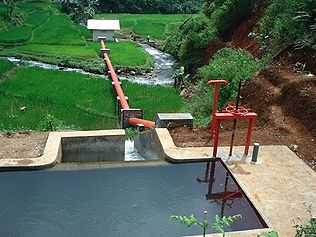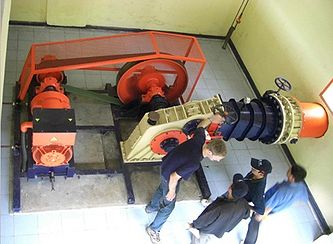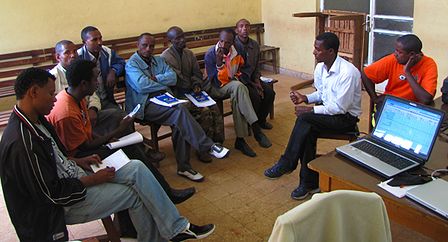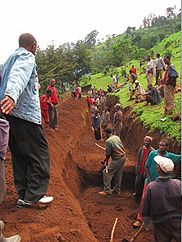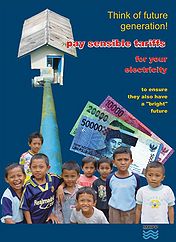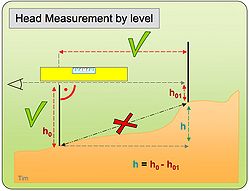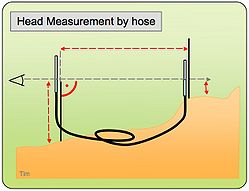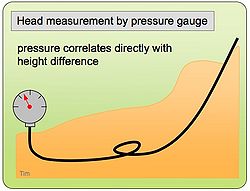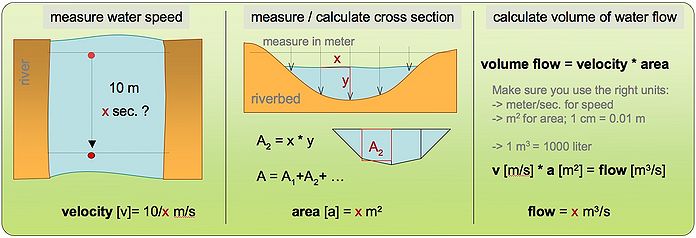Knowledge fuels change - Support energypedia!
For over 10 years, energypedia has been connecting energy experts around the world — helping them share knowledge, learn from each other, and accelerate the global energy transition.
Today, we ask for your support to keep this platform free and accessible to all.
Even a small contribution makes a big difference! If just 10–20% of our 60,000+ monthly visitors donated the equivalent of a cup of coffee — €5 — Energypedia would be fully funded for a whole year.
Is the knowledge you’ve gained through Energypedia this year worth €5 or more?
Your donation keeps the platform running, helps us create new knowledge products, and contributes directly to achieving SDG 7.
Thank you for your support, your donation, big or small, truly matters!
Difference between revisions of "Hydro Power Basics"
***** (***** | *****) |
***** (***** | *****) |
||
| Line 55: | Line 55: | ||
== <span>Components of a Micro</span> Hydro system == | == <span>Components of a Micro</span> Hydro system == | ||
| − | [[Image:Depok.jpg|780x206px|Depok.jpg]] civil structure <br> | + | Of course there are the construction a mhp consists of: divertion constructions in the river, Guiding water per canal and pipe, the electromechanical equipment to turn water power into electricity plus transmission lines and house connections. Nevertheless if it is community based, main challenge will be the "software". The people of the community who will build / use the mhp have to be introduced, trained, learned and encouraged to organise, operate and manage their power station. A sustainable working mhp scheme requires users who are enabled to understand "their" system.<br> |
| + | |||
| + | [[Image:Depok.jpg|780x206px|Depok.jpg]] '''civil structure '''<br> | ||
{| width="50%" cellspacing="1" cellpadding="1" border="0" | {| width="50%" cellspacing="1" cellpadding="1" border="0" | ||
| Line 64: | Line 66: | ||
forebay, spillway, trash rack, | forebay, spillway, trash rack, | ||
| − | penstock (incl. breather pipe, trust & support blocks) | + | '''penstock''' (incl. breather pipe, trust & support blocks)<br> |
| − | |||
| − | <br> | ||
| [[Image:Powerhouse 2.jpg|right|333x245px|Powerhouse 2.jpg]] | | [[Image:Powerhouse 2.jpg|right|333x245px|Powerhouse 2.jpg]] | ||
| − | + | '''electro-mechanical equipment''': | |
| − | generator and crossflow turbine mounted on | + | generator and crossflow turbine mounted on base frame |
|} | |} | ||
Revision as of 13:14, 14 June 2010
Mini/Micro Hydropower
Principle
A mass of water moving down a height difference contains energy. This can be harvested. Moving water drives some waterwheel/turbine. This rotation either drives machinery directly (e.g. mill, pump, hammer, thresher, ...) or is coupled with a generator which produces electric power.
Hydropower is probably the first form of automated power production which is not human/animal driven. Moving a grind stone for milling first, developed into the driving of an electrical generator. Next to steam it was for long the main power source for electricity.
Its continual availability does not require any power storage (unlike wind/solar power). It is mainly mechanical hardware. This makes it relative easy to understand and repair-/maintain-able. In smaller units its environmental impact becomes neglect-able (see: environmental impact assessment) .
Hydropower requires specific conditions:
- a (constant) amount of water flow
- a height difference
These specific conditions limit generalising and standartisation of "how to install hydropower plants". Choosing the right location and planning requires some specific knowledge. With knowledge of water flow and height difference the potential power can be estimated.
Classification of size
There is no binding definition how Minihydropower output is to be classified. Rules for communication avoiding misunderstandings: Generally the terms can be used "downwards compatible". Pico- is also Mini- but not visa versa. Specific terms (Pico, Family) should be used only if they are required to indicate specifics. The power output is only an approximate diversion between different classes. Specify the power output in numbers if you talk about actual installations. The spectrum needs higher diversification as smaller it becomes as there are certain differences in technique, usage, applicability and replicability.
| Mini (MH) |
< 1 MW | grid connected | special know how required |
| Micro | < 100 kW | partially grid con. | professional know how required |
| Pico (PH) | < 10 kW | island grids | small series units produced locally; professional equipment available |
| Family (FH) | < ~1 kW | single households/clusters | often locally handmade solutions; professional equipment available |
Comments:
- all installations require "special" knowhow
- there are "over the counter" pico turbines available for "self installation"
- Micro hydro is perhaps the most mature of the modern small-scale energy supply technologies used in developing countries. There are thought to be tens of thousands of plant in the “micro” range operating successfully in China[1], Nepal, Sri Lanka, Pakistan, Vietnam and Peru.
- Historically the term hydropower developed from naming very small units towards nowadays huge dams. Then there where new terms created to separate different clusters. All of them are hydropower. What is considered "mini or "micro" may be defined once and forever ... or not. If there are different opinions on this topic you're welcome to open a discussion group on this.
Components of a Micro Hydro system
Of course there are the construction a mhp consists of: divertion constructions in the river, Guiding water per canal and pipe, the electromechanical equipment to turn water power into electricity plus transmission lines and house connections. Nevertheless if it is community based, main challenge will be the "software". The people of the community who will build / use the mhp have to be introduced, trained, learned and encouraged to organise, operate and manage their power station. A sustainable working mhp scheme requires users who are enabled to understand "their" system.
|
forebay, spillway, trash rack, penstock (incl. breather pipe, trust & support blocks) |
electro-mechanical equipment: generator and crossflow turbine mounted on base frame |
|
Information of chances and efforts a hydropower plant requires |
Participation of community |
Organisation & Management |
Suitable conditions for micro-hydro power
Again, "head and flow" matter. The best geographical areas for exploiting small-scale hydro power are those where there are steep rivers flowing all year round. The Andes, the Himalayas, islands with moist marine climates, such as the Caribbean Islands, the Philippines and Indonesia are widely suitable. Laos, Vietnam and wide parts of China use Micro Hydropower in large numbers.
A locations, head, flow and number of consumers allow to calculate the available power share per consumer
Minimal Head may be 1-2 m. For considerable power then much water (> 1 m3) is required
Minimal Flow may be 20 l/s. Power is according to head output (see power estimation).
Mini Hydropower operates constantly and requires little maintenance. It is ideal for powering remote regions. Although grid connection is very feasible due to its very low operational costs.
Brief site assessment:
- location Data
- head, flow
- length of powerline
- length of penstock
- land use
=> a two page condensed site assessment
Flow measures in feasibility studies:
Flow data should be gathered over a period of at least one year where possible, so as to ascertain the fluctuation in river flow over the various seasons.
At least measures must be taken during dry season to assure that there is always enough water to power the turbine. Too little water results in power cut. If such is not clear to consumers from begin with it can seriously endanger the projects success.
Measuring Head & Flow
First step to judge a sites hydropower potential is to measure/estimate head and flow.
- Head (the vertical distance between the intake and turbine)
- Flow (how much water comes down the stream)
Head is very often exaggerated as is the flow rate, which varies over the year!
Wrong data occurs frequently. Confirmation of existing data is highly recommended!
Head and flow are the two most important facts of a hydro site. This will determine everything about the hydro system—volume of civil constructions, pipeline size, turbine type and power output. Inaccurate measurements result in low efficiency, high cost and scarcity of power.
Methods of head and flow measurement without sophisticated tools
Estimation of height can be done easiest if there is a steep slope (waterfall)by rope. Principle of a step by step head measurement:
By measuring total height step by step, it's crucial to do the bearing strictly horizontally. Ensure that by using a level or a water filled hose. Widely available are hoses and pressure gauges which allow the easiest method of height measurement. As longer the hose as less steps have to be taken to measure the total head.
Estimation of flow is very difficult without measurement. A quick and easy way to measure is the floating method
First, measure the waters speed at an steady flowing part of the river. Therefore drop some item and stop the time it needs for a certain distance to float. Second, do a sketch of the rivers cross section by measuring its depth every 20-50 cm so you come up with a grid showing the rivers profile from side to side. With this data its cross sections area can be calculated easily. Finally the flow volume results from (water) speed x (section) area.
Example:
A ball drifts 10 m in 12 s => speed = 10m/12s = 0.12 m/s.
Cross section => A1= 25 cm * 40 cm (0.25 m * 0.4 m) = 0.1 m2 ; A1+A2+ ... = A = 0.5 m2
Flow volume = 0.12 m/s * 0.5 m2 = 0.06 m3/s => 60 l/s
To estimate a sites potential cost its necessary to know additionally:
- Pipeline (penstock) length
- Electrical transmission line length (from turbine to consumer). As smaller the sites power output as higher the power lines cost share
- Number of potential customers
Units and power estimations
Power: watts [W] or Kilowatts [kW] 1 kW = 1000W
Flow: 1 m³/s = 1000 l/s
Gross heat: height difference the water "falls down"
Net head: a little smaller than gross head. Gross head deducted by energy loss due to friction in penstock
Potential power is calculated as follows:
Power [W] = Net head [m] x Flow [ l/s] x 9.81 [m/s²] (est. gravity constant) x 0.5 (turbine/generator efficiency)
Potential power is estimated as follows:
Power output [W] = height [m] * flow [l/s] * 5
More accurate estimations take into consideration:
- exact net head (intake to powerhouse)
- exact flow (constant during the year?)
- combined efficiency of turbine and generator (depends on quality, est. 60% = 0.6)
Example:
A 6 m high waterfall has 300 liter/sec => potential power est. : 6 m * 300 l/s * 5 = 9000 W = 9 kW
The economics of microhydro systems
Normally, small-scale hydro installations in rural areas of developing countries can offer considerable financial benefits to the communities served, particularly where careful planning identifies income-generating uses for the power.
The major cost of a scheme is for site preparation and the capital cost of equipment. In general, unit cost decreases with a larger plant and with high heads of water. It could be argued that small-scale hydro technology does not bring with it the advantages of 'economy of scale', but many costs normally associated with larger hydro schemes have been 'designed out' or 'planned out' of micro hydro systems to bring the unit cost in line with bigger schemes. This includes such innovations as:
• using run-of-the-river schemes where possible - this does away with the cost of an expensive dam for water storage • locally manufactured equipment where possible and appropriate
• use of HDPE (plastic) penstocks where appropriate
• electronic load controller - allows the power plant to be left unattended, thereby reducing labour costs, and introduce useful by-products such as battery charging or water heating as dump loads for surplus power; also does away with bulky and expensive mechanical control gear
• using existing infrastructure, for example, a canal which serves an irrigation scheme
• siting of power close to village to avoid expensive high voltage distribution equipment such as transformers
• using pumps as turbines (PAT) - in some circumstances standard pumps can be used 'in reverse' as turbines; this reduces costs, delivery time, and makes for simple installation and maintenance
• using motors as generators - as with the PAT idea, motors can be run 'in reverse' and used as generators; pumps are usually purchased with a motor fitted and the whole unit can be used as a turbine/generator set
• use of local materials for the civil works
• use of community labour • good planning for a high plant factor (see above) and well balanced load pattern (energy demand fluctuation throughout the day)
• low-cost connections for domestic users (see following chapter on this topic)
• self-cleaning intake screens - this is a recent innovation which is fitted to the intake weir and prevents stones and silt from entering the headrace canal; this does away with the need for overspill and desilting structures along the headrace canal and also means that, in many cases, the canal can be replaced by a low-pressure conduit buried beneath the ground - this technology is, at present, still in its early stages of dissemination


